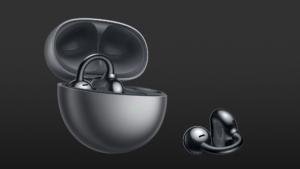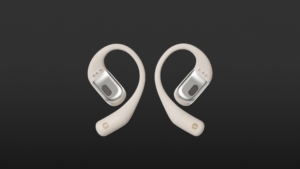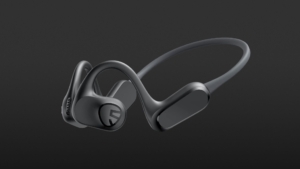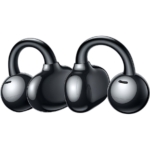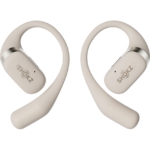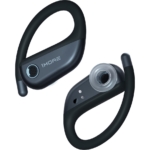The Tribit StormBox Flow is a compact, rugged “can-take-it-anywhere” speaker.
Open-ear headphones: Not in your ears, but in front of them.
Unlike normal headphones, open-ear headphones keep the ear canal free for ambient noise. This open design means that open-ear headphones are ideal for many outdoor activities, such as hiking, running or cycling, thanks to their airborne sound transmission. In other words, for anything where you need to be aware of your immediate surroundings.
Table of contents
- Three typical open-ear designs: The Huawei Free Clip are worn like an ear clip.
- The Shokz OpenFit are hung over the auricle.
- And the SoundPEATS RunFree Lite come with a hook.
Whether you’re a sports enthusiast, a daily commuter or simply someone looking for a way to enjoy music on the go, open headphones could be the perfect solution for you. However, professional use in certain industries is also conceivable. For example, working in construction or event management requires constant communication with the environment. Open-ears allow you to do just that without compromising safety or efficiency.
How do open-ear headphones work?
In contrast to bone conduction headphones (see guide), which transmit sound to the cheekbones via vibrations, open-ear headphones work with small loudspeakers.
They are designed to sit directly in front of and therefore outside the ear canal without sending vibrations through the bones. These devices project the sound towards the ear in such a way that you can still hear outside noises and your audio content is mixed with the ambient noise.
The advantages of open-ears
Safety
The biggest advantage of open-ear headphones is that they guarantee situational awareness at all times. This is particularly important for outdoor activities such as running, cycling or hiking, where being aware of your surroundings significantly improves safety. As ambient sounds reach your eardrums unhindered, you can enjoy your favourite podcasts or music while being aware of approaching vehicles, people or potential dangers.
Comfort
Open-ears may be suitable for you if you find wearing in-ear or over-ear models uncomfortable. Many open-ear models are simply hooked over the ear cups and fit securely and comfortably. As a rule, they also don’t bother people who wear glasses. However, due to the different designs – both for open-ears and glasses – we recommend trying them out.
Hygiene issues
As these headphones do not sit directly in the ear canal, they minimise the risk of ear infections or discomfort when worn for long periods. This is particularly beneficial for those of you who want or need to use headphones over a longer period of time.
Buying open-ear headphones – what you need to consider
Sound quality compared to traditional headphones
Although open-ear headphones offer considerable advantages in terms of safety and comfort, they cannot match the sound quality of conventional headphones, especially in terms of bass reproduction and sound insulation. You should therefore carefully weigh up your priorities and consider whether the advantages of the open design outweigh the compromises in sound quality.
Battery life
Battery life is always a very important aspect for wireless models. You should therefore look for headphones that have enough battery life to cope with your daily activities or training without constant charging. You should also check whether your potential candidate has a fast-charging function and how often the charging case can charge the headphones. If wireless charging is important to you, you should also take this into account when making your choice.
Longevity & durability
Durability is also crucial, especially for those who are outdoors and/or undertaking strenuous activities; a waterproof and robust construction ensures that the headphones can withstand dust, dirt, water and physical strain.
Therefore, look for a high IPX rating (e.g. IP54, IP67, IPX7), which stands for a certain level of water and sweat resistance.
Compatibility with glasses and helmets
If you wear glasses or a helmet, you should consider your own equipment. Do the temples of your sports glasses fit or do they press on your ears or headphones? Does your cycling helmet or its straps cover your ear cups?
While open-ears are generally more compatible with helmets and goggles than traditional over-ear and on-ear headphone models, it’s important to look for options that fit comfortably with all your wearables.
Bluetooth: range and connectivity
The built-in Bluetooth technology is another important aspect. On the one hand, the range is important because you don’t always want to or can’t carry your smartphone with you as a player. A good range (at least 10 metres) ensures greater freedom of movement without signal drops or interruptions.
You should also make sure that both your player (usually your smartphone) and the open-ear headphones have high-quality Bluetooth codecs (see guide).
Tips for maintenance
To ensure that your open-ear headphones last as long as possible, you should follow these care tips:
Cleaning and storage
Clean your headphones regularly with a soft, dry cloth. Waterproof headphones can of course also be cleaned with a damp cloth. Always store the headphones in the charging case supplied to prevent damage when they are not in use. Further care tips can be found here.
Extend the service life
Avoid exposing your headphones to extreme temperatures (e.g. leaving them in the car in summer) and keep them away from objects that could scratch or damage them. Also make sure that the batteries are charged regularly, especially if you do not use the headphones for a long time. This protects the battery and prevents deep discharge.
The most popular open-ear headphones on headphonecheck.com
Huawei FreeClip
Lightweight, innovative open-ear earphones with superb wearing comfort
1more Fit Open Earbuds S50
Open-ear headphones for sport and communication
→ read the review here
Conclusion
Open-ear headphones offer you a convenient way to stay in touch with your surroundings while enjoying pretty good sound. However, you should not forget that these types of headphones do not (yet) sound as good as normal over-ear or in-ear headphones.
Whether for reasons of safety, comfort or integration – the advantages of open-ears are obvious. When choosing open-ear headphones, pay attention to the technical data, the experiences of other users and check independent test reports.
* Affiliate links
Prices marked with “*” are affiliate links. These advertising links help us to finance our site. If you buy something via these links, we receive a small commission, but the price remains the same for you. Thank you for your support!
Similar Reviews
The Shokz OpenMeet is an open headset designed for everyday office use, offering excellent wearing comfort and a lightweight construction.
The Huawei FreeArc delivers powerful audio, pleasant wearing comfort, and a secure hold in a stylish open design.
The LG xboom Buds are part of the current xboom lineup, featuring graphene drivers, impressive battery life, and Auracast support.
The Beats Powerbeats Pro 2 are the “AirPods Pro” for athletes, representing a significant update compared to the 2019 predecessor.
